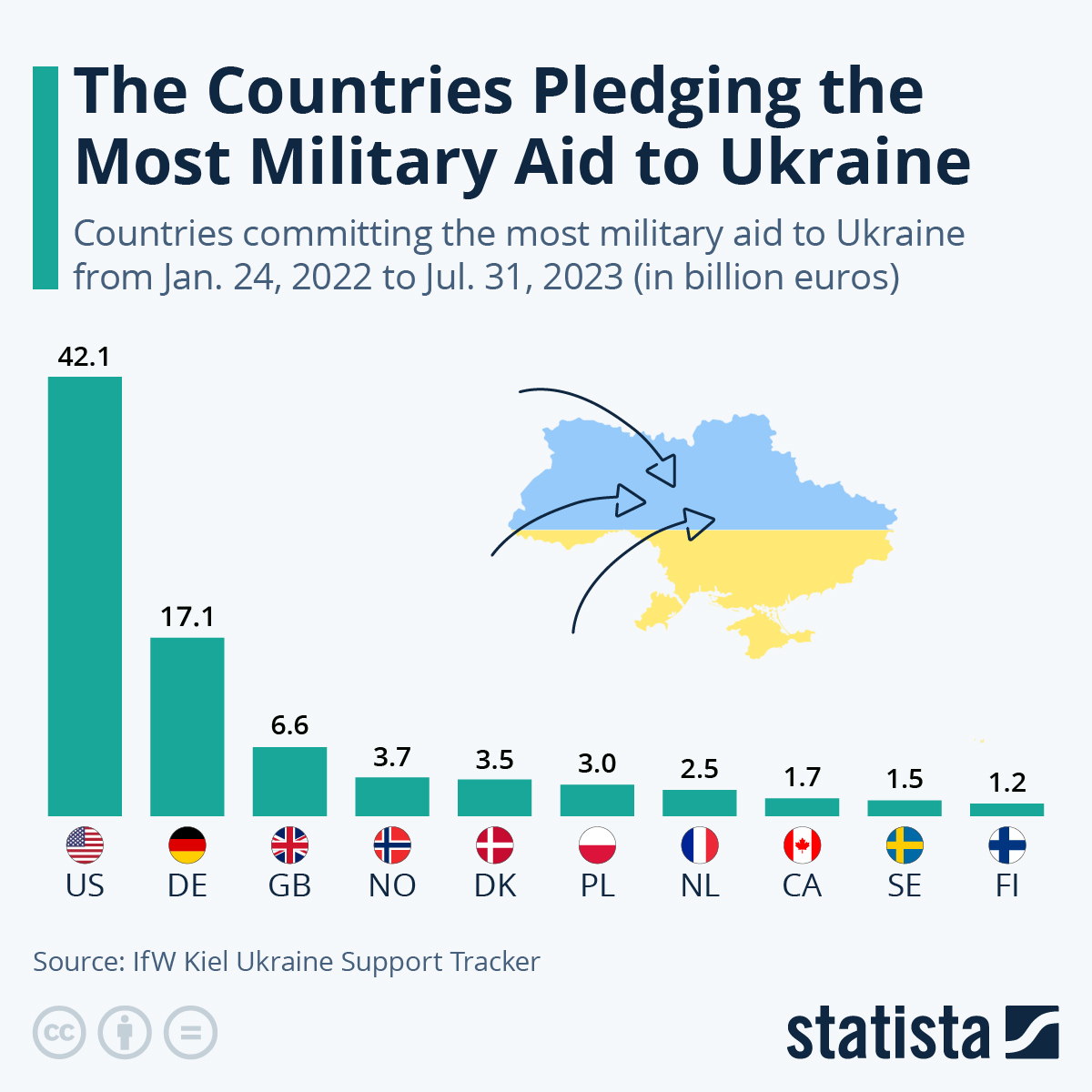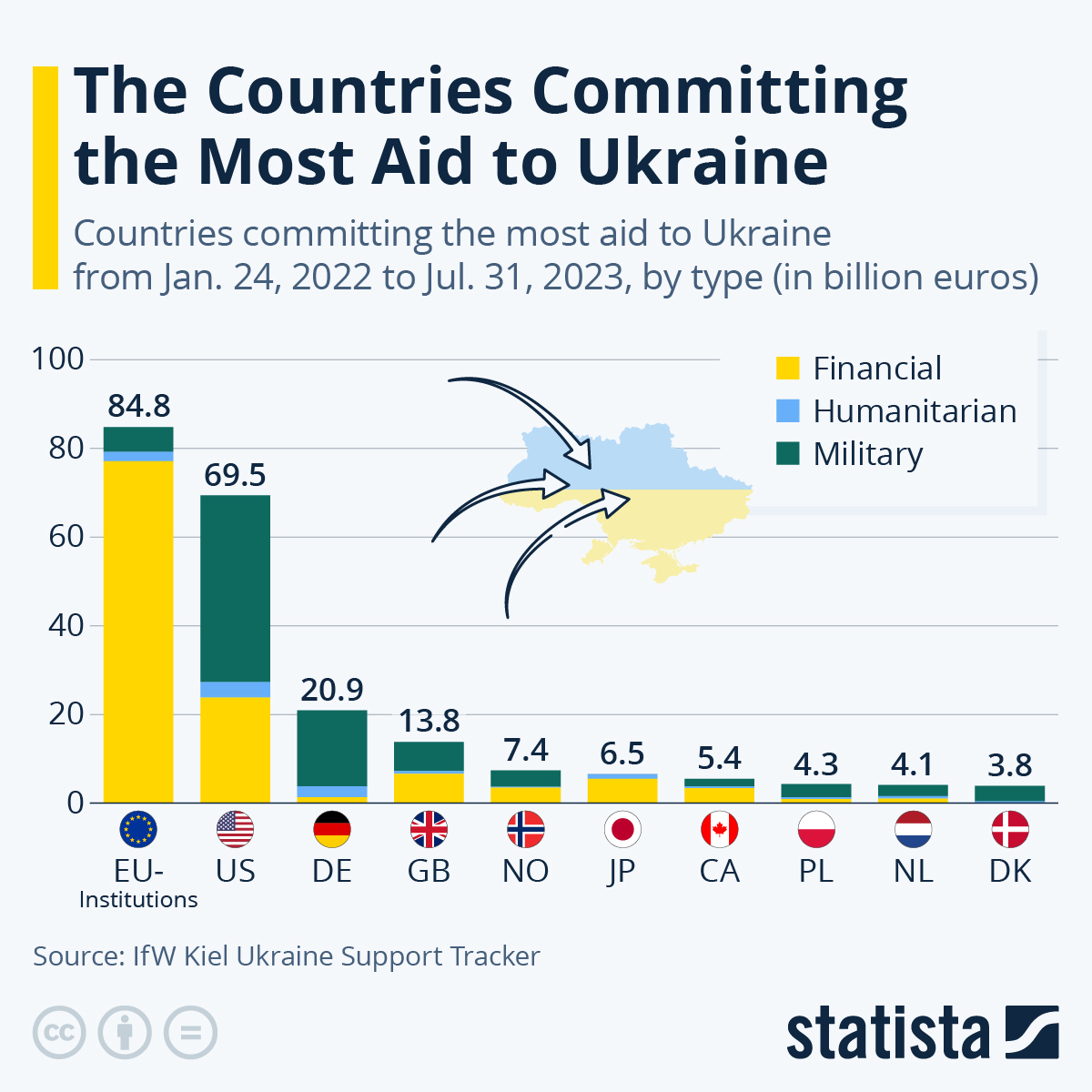
On Wednesday, amid a diplomatic dispute over Ukrainian grain exports, Polish Prime Minister Mateusz Morawiecki said Poland is “no longer transferring any weapons to Ukraine because we are now arming ourselves with the most modern weapons”.
A government spokesman clarified on Thursday that the country would continue "providing supplies of ammunition and armaments that had previously been agreed to".
As Statista's Martin Armstrong shows in the following infographic, using data from the Ukraine Support Tracker by the Kiel Institute for the World Economy, Poland has been one of Ukraine's most important military aid partners since the war began.
In a boost for Kyiv, Ukraine President Zelensky welcomed the news on Thursday that its largest military aid donor, the United States, had committed to sending a further $325 million.
You will find more infographics at Statista
Looking at pledges of military aid to Ukraine between January 24, 2022 and July 31, 2023, the U.S. government committed a total of €42.1 billion.
In relative terms, however, this military aid commitment amounts to approximately 0.2 percent of U.S. GDP. Looking at this metric, Ukraine's smaller neighbors have, relatively, contributed more to the war effort: For example Estonia (1.3 percent of GDP) or Lithuania (1.2 percent). Poland's military aid commitments have been equivalent to 0.5 percent of its GDP.
Additionally, as the chart below shows, thanks chiefly to the €77.1 billion in pledged financial aid, European Union institutions are the largest aid donors to Ukraine. This is based on data from the IfW Kiel Ukraine Support Tracker which currently covers the period January 24, 2022 to July 31, 2023.
You will find more infographics at Statista
Ukraine's largest military aid partner since the start of the war, the United States, has committed a total of €69.5 billion in aid when also considering financial and humanitarian support.
Germany, the United Kingdom and Norway have been the next most significant pledgers of aid.
On Wednesday, amid a diplomatic dispute over Ukrainian grain exports, Polish Prime Minister Mateusz Morawiecki said Poland is “no longer transferring any weapons to Ukraine because we are now arming ourselves with the most modern weapons”.
A government spokesman clarified on Thursday that the country would continue “providing supplies of ammunition and armaments that had previously been agreed to”.
As Statista’s Martin Armstrong shows in the following infographic, using data from the Ukraine Support Tracker by the Kiel Institute for the World Economy, Poland has been one of Ukraine’s most important military aid partners since the war began.
In a boost for Kyiv, Ukraine President Zelensky welcomed the news on Thursday that its largest military aid donor, the United States, had committed to sending a further $325 million.
You will find more infographics at Statista
Looking at pledges of military aid to Ukraine between January 24, 2022 and July 31, 2023, the U.S. government committed a total of €42.1 billion.
In relative terms, however, this military aid commitment amounts to approximately 0.2 percent of U.S. GDP. Looking at this metric, Ukraine’s smaller neighbors have, relatively, contributed more to the war effort: For example Estonia (1.3 percent of GDP) or Lithuania (1.2 percent). Poland’s military aid commitments have been equivalent to 0.5 percent of its GDP.
Additionally, as the chart below shows, thanks chiefly to the €77.1 billion in pledged financial aid, European Union institutions are the largest aid donors to Ukraine. This is based on data from the IfW Kiel Ukraine Support Tracker which currently covers the period January 24, 2022 to July 31, 2023.
You will find more infographics at Statista
Ukraine’s largest military aid partner since the start of the war, the United States, has committed a total of €69.5 billion in aid when also considering financial and humanitarian support.
Germany, the United Kingdom and Norway have been the next most significant pledgers of aid.
Loading…





